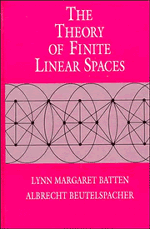Book contents
- Frontmatter
- Contents
- In memory of PAUL de WITTE 1931–1980
- Preface
- 1 The essentials
- 2 Complementation
- 3 Line sizes
- 4 Semiaffine linear spaces
- 5 Semiaffine linear spaces with large order
- 6 Linear spaces with few lines
- 7 d-Dimensional linear spaces
- 8 Group action on linear spaces
- Appendix
- Notation index
- Subject index
4 - Semiaffine linear spaces
Published online by Cambridge University Press: 05 May 2010
- Frontmatter
- Contents
- In memory of PAUL de WITTE 1931–1980
- Preface
- 1 The essentials
- 2 Complementation
- 3 Line sizes
- 4 Semiaffine linear spaces
- 5 Semiaffine linear spaces with large order
- 6 Linear spaces with few lines
- 7 d-Dimensional linear spaces
- 8 Group action on linear spaces
- Appendix
- Notation index
- Subject index
Summary
I-Semiaffine linear spaces
If (p,L) is a non-incident point-line pair, we denote by π (p,L) the number of lines through p which miss L. Using this notation, a linear space containing a quadrangle is a projective plane if and only if π (p,L) = 0 for every non-incident point-line pair. Likewise, a linear space containing a triangle is an affine plane if and only if π (p,L) = 1 for every non-incident point-line pair.
G. Pickert (1955) was the first to ask a natural generalization of these facts: What non-trivial linear spaces are characterized by
π(p,L) ≤ 1
for every non-incident point-line pair?
In 1962, P. Dembowski gave a complete description of all such finite linear spaces, which he proceeded to call semiaffine planes. (Hence, the term ‘semiaffinity condition’ used in Section 1.4.) As P. Dembowski mentions in his 1962 paper, N. Kuiper had at about the same time, and independently, proved the same result. It is therefore now usually referred to as the Kuiper–Dembowski theorem. The aim of the first section of this chapter is to prove this result.
In subsequent sections we shall make yet a further generalization: Let I be a set of non-negative integers. S is said to be I-semiaffine if π (p,L) ∈ I for every non-incident point-line pair (p,L) of S. S is said to be I-affine if S is I-semiaffine but not J-semiaffine for any proper subset J of I.
- Type
- Chapter
- Information
- The Theory of Finite Linear SpacesCombinatorics of Points and Lines, pp. 68 - 95Publisher: Cambridge University PressPrint publication year: 1993



